Many fruit, nut, and landscape trees can succumb to root rot caused by three types of fungi and a group of water molds (that used to be considered fungi); these include the fungi Armillaria, Phymatotrichum, and Xylaria and the water mold Phytophthora.
The trees show varying symptoms from these different diseases.
However, in all cases, there is a distressing tendency for the trees to be so weak that they lean or even break near the soil line.
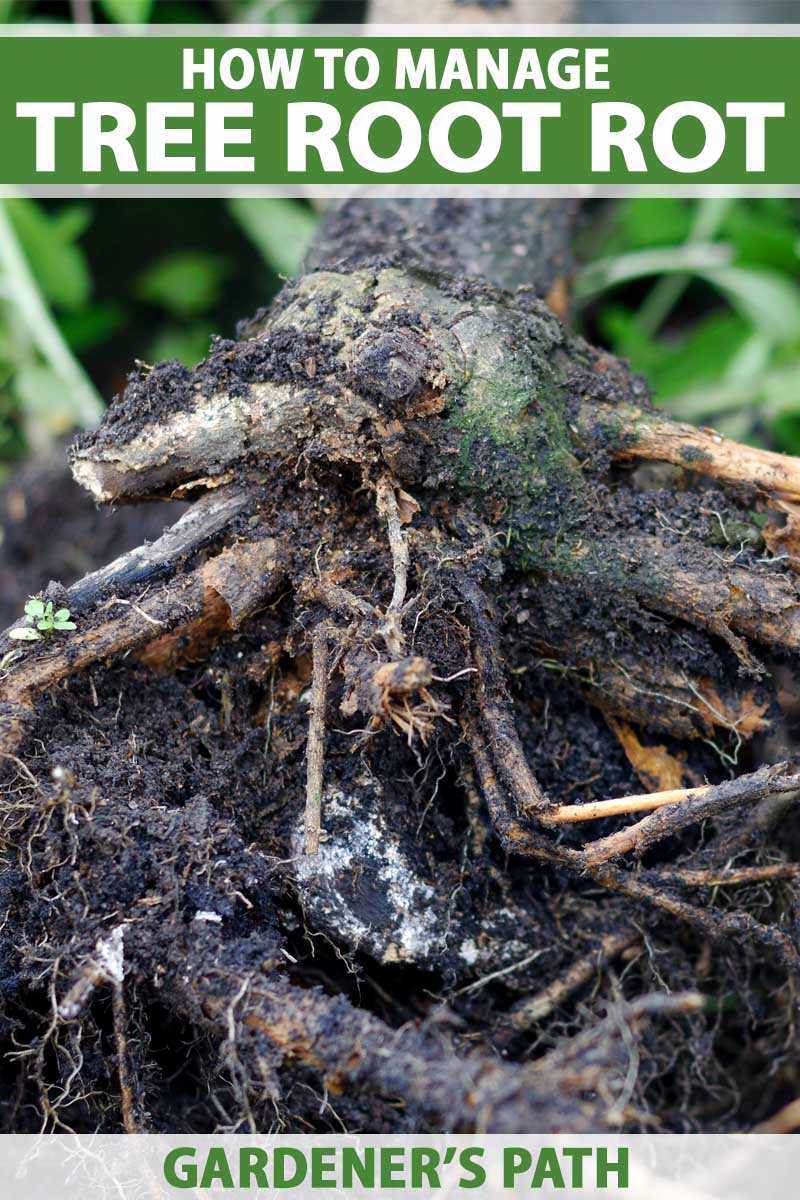
We link to vendors to help you find relevant products. If you buy from one of our links, we may earn a commission.
There is no easy cure for any of these diseases. Trying to prevent them is your best bet. So read on to learn about these disturbing diseases, so you know what to look for.
What You Will Learn
Phytophthora Root Rot
Phytophthora species have such a strong preference for moist soils that they are known as water molds. The infamous species Phytophthora infestans caused the Irish potato famine in the late 1800s and the death of one million Irish.
Despite this term, they are now classed in a separate kingdom (the oomycetes) and are no longer considered fungi. However, they act like them!
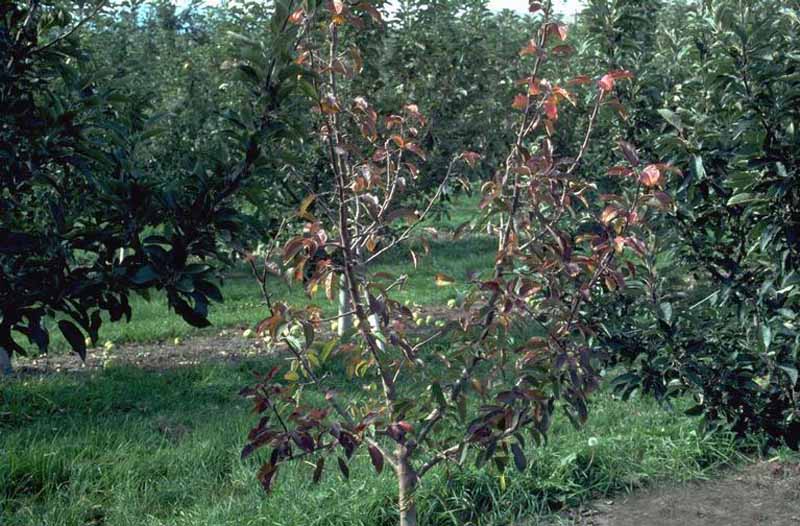
A large number of these organisms cause root rot on a huge array of plants. However, in trees and shrubs, the species primarily responsible for root rot is Phytophthora cactorum.
While you might expect this type of root rot to only be a problem in moist areas, vegetation in dry areas can also be susceptible. Irrigation can result in wet soils and increase the susceptibility to this type of root rot.
These organisms have two types of spores. Oospores are thick-walled spores that can lurk in the soil for a long time and strike when conditions are moist. Other types of spores (zoospores) can swim, so they can travel across the soil in irrigation water or runoff. This enables them to quickly infect large numbers of trees.
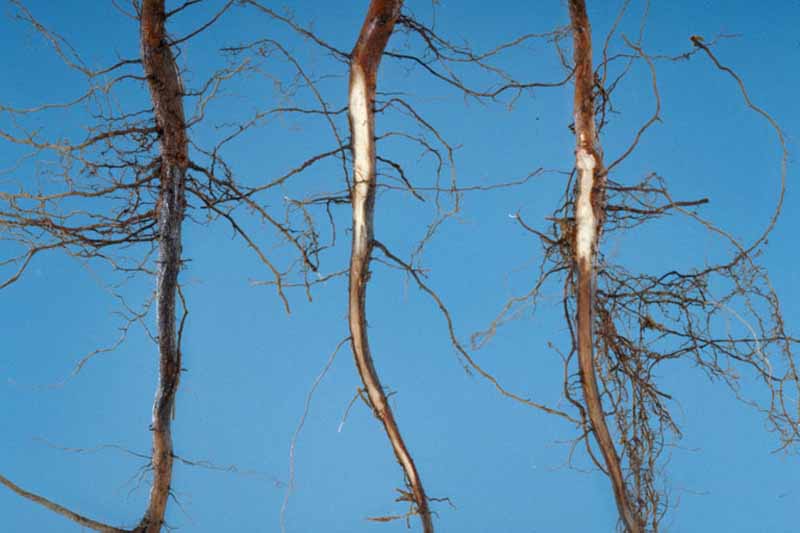
If your tree or shrub is suffering from just Phytophthora root rot and not the other kinds of diseases it causes (collar and crown rot), there is some chance that it can recover. This can happen if conditions become unfavorable to the pathogen, such as becoming warmer and drier.
How to Tell if the Roots of Your Apple Tree are Infected by Phytophthora
So many factors can cause decline that it can be difficult to determine what is causing these symptoms. If you think your tree might be under siege by Phytophthora, dig up the soil around the roots and look at the fine ones.
They might be orange or brown, and the primary roots might be shedding off the fine ones. In contrast, roots that are drowning due to wet soil will be brown overall and might smell decayed or fermented.
Cultural Controls
1. Monitor Irrigation Water
The use of overhead sprinklers can quickly spread Phytophthora onto trees. As an example of how dangerous irrigation canals can be, scientists isolated 749 specimens from irrigation canals in eastern Washington State. The way to check the water for these organisms is to suspend fruit in it and look for visible fruit rots.
2.Limit the Saturation of the Soil
Monitor your soil moisture and only irrigate when needed, since free water greatly increases the chances of the spread of this pathogen.
3. Plan Ahead if You Know Phytophthora is in Your Area
Try to plant in well-drained soil. For fruit and nut trees, you can also sometimes find rootstocks that are resistant to this pathogen.
However, resistance in rootstocks varies depending on the particular species of Phytophthora. So be sure and have your soil tested to determine the exact species before you choose a variety to plant.
4. Biologicals and Biopesticides
Fortunately, microbes in the soil are waging constant war against each other, and you can harness that trend to your advantage.
Many types of soil bacteria and fungi can outcompete root rot organisms. For example, a classic biocontrol fungus that is widely used is Trichoderma.
You can encourage the growth of such organisms by adding a lot of organic matter to the soil. Grass clippings and compost are a good place to start.
Fungicides
Only certain compounds will work on Phytophthora, since they are not true fungi.
For the root zone, treat the entire area and not just near the base of the tree with the following compounds:
- Metalaxyl
- Mefenoxam
Trunk and root zone sprays that should not be combined with a copper-spray program include the following:
- Phosphorous acid, salts of mono- or di-potassium
- Fosetyl Al
Armillaria Root Rot
The honey mushroom or shoestring fungus, Armillaria mellea, also menaces a large number of plants. Not only is it found in a large number of soils, it has a very large host range.
It is truly a giant fungus – its mycelia can spread for miles – giving it the designation of the largest organism in the world.

And to make things worse, the mycelia can survive for decades in dead root tissue and stumps. Stone fruits are the most susceptible, while apple trees are moderately susceptible.
How to Tell if Your Tree Has Armillaria Root Rot
Symptoms can range from the obviously horrendous, such as the sudden collapse of the tree in the middle of the summer, to more subtle ones. Your tree’s terminal shoot growth may be reduced, and the leaves may turn purple much earlier than they should.
You can diagnose Armillaria root rot by checking the base of your tree beneath the soil. The wood can show a white rot. If you remove the outer bark from the roots, they may look spongy and stringy (hence the name shoestring fungus).
If the tissue is actively decaying, the mycelia may be bioluminescent. Another giveaway can be the production of clusters of honey-colored or light-brown mushrooms at the base of the tree.
It May Be Too Late for Your Tree
Your best bet is to try and avoid this fungus in the first place. Try and remove all pieces of wood and roots from the soil before you plant your tree, since the fungus lives on in dead tissue.
Also try to protect your tree from stress. Adjust the pH of the soil and grow cover crops.
The amount of variation in this fungus can make it difficult to choose a resistant type of rootstock. A rootstock that is resistant in one test may be susceptible in another.
Black Root Rot
As if the previous types of root rots aren’t bad enough, there is another type of root rot that tends to affect older apple trees and hardwood trees, such as walnuts and elm. Two species of fungi, Xylaria mali and Xylaria polymorpha, cause this disease.
Black root rot also goes by the dramatic name of dead man’s fingers due to its production of structures that look like blackened fingers. These are found on decaying root surfaces.
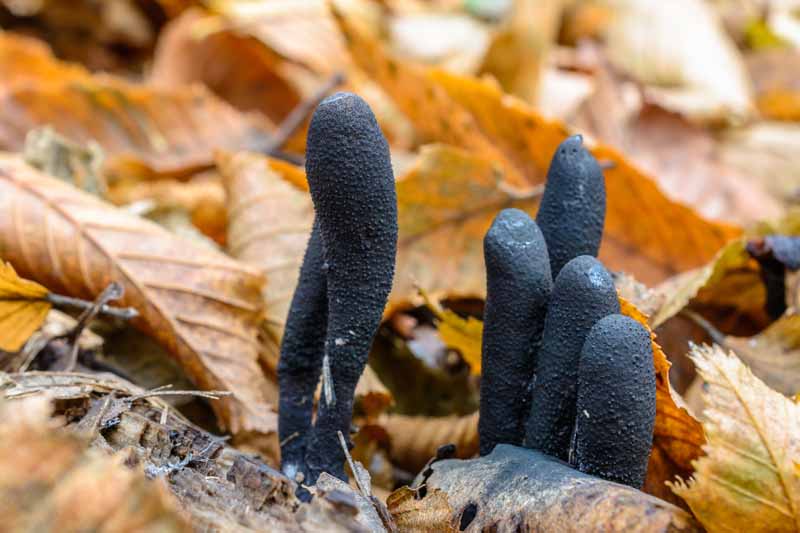
Although trees of any age can come down with this infection, those that die are usually at least 10 years old.
Since the fungus can live on root fragments for up 15 years after you remove the infected tree, you will not be able to plant another apple tree on that site. However, if the site has deep soil and is well-drained, you can plant peach trees, since they are not susceptible.
Cotton Root Rot
Cotton root rot is a devastating disease that also goes by the names of Texas root rot or its scientific name of Phymatotrichum root rot.
The species name of this fungus, Phymatotrichum omnivorum, translates to “eats everything.”
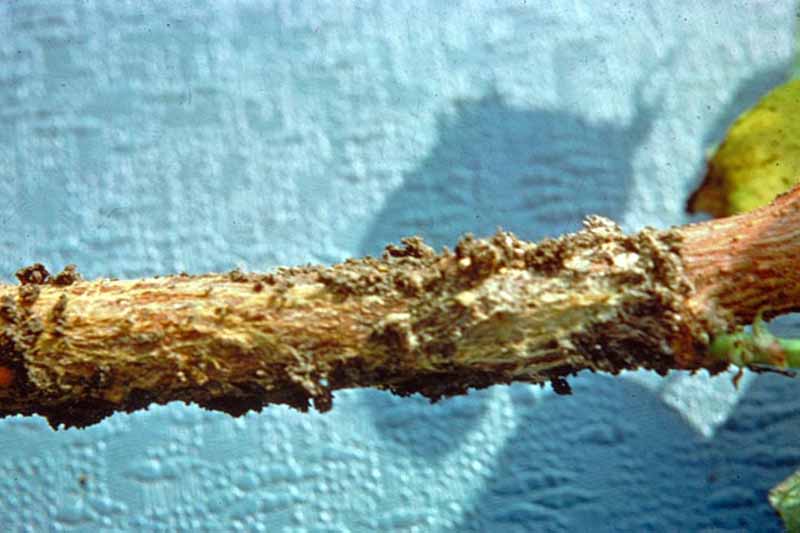
That is an apt name for the fungus, since it can attack more than 2,300 species of broadleaf plants. Strangely, it can infect every kind of fruit tree except for pomegranates.
Fortunately for most fruit tree growers, this aggressive fungus is only found in soils that are heavy and alkaline – those that are common in the southwest – and soils that are below 5,000 feet.
Cotton root rot attacks when the soil is warm and moist – typical post-monsoon weather. The fungus spreads when an infected root touches an uninfected one. To complicate matters, Texas root rot can survive indefinitely on native vegetation like mesquite trees.
Also, the fungus can attack its hosts indiscriminately. For example, cotton root rot fungi from cotton can infect apple trees. This is a particular problem, since many housing tracts in the southwest are located on old cotton or alfalfa fields.
Even worse – the resting structures of the fungus survive for many years in soil more than 12 feet deep.
How to Tell if Your Tree has Cotton Root Rot
The only way to positively ID this infection is in a lab, but you can make a good guess based on the symptoms and the knowledge that the fungus is active in your area.
Your tree may wilt suddenly in the heat, and leaves (dead or dying) will remain attached to the tree even after it dies. The branches can wilt permanently as quickly as two weeks after you see the first signs of the disease.
Your tree is probably a goner, since there are no good controls for cotton root rot – even though the fungus has been studied since 1888.
You May be Able to Save Your Tree
If you notice the infection early enough, there is a chance to save your tree.
First, aggressively treat the soil. Add large quantities of ammonium sulfate and soil sulfur and then water deeply. The idea is to lower the soil pH when these fertilizers leach into the deep soil.
This serves two purposes. One is to inhibit the fungus, and the other is to encourage soil microbes that might be able to fight Phymatotrichum.
If this technique is successful, you need to repeat it every year. If not, the soil will revert back to favorable conditions for the fungus, which will return with a vengeance.
If you cannot save your tree, at least the soil will be ready for planting next year – hopefully with a resistant tree.
Read more about preventing, identifying, and treating cotton root rot here.
All Types of Root Rot Can be Fatal
Prevention is your best bet in all cases of root rot. Make sure you plant your apple tree in well-drained soil to protect against Phytophthora root rot. Minimizing the amount of moisture in the soil can help protect against this water mold.
Also treating your soil with biocontrol agents and using cultural practices that encourage the growth of these types of soil organisms can help in the battle against Phytophthora root rot.
If you know your area has a history of Armillaria root rot, you should prepare for planting by picking old tissue such as chunks of wood and dead roots out of the soil. The fungus can live in these types of tissue for years. Keeping your tree safe from stress can help to keep this fungus at bay.
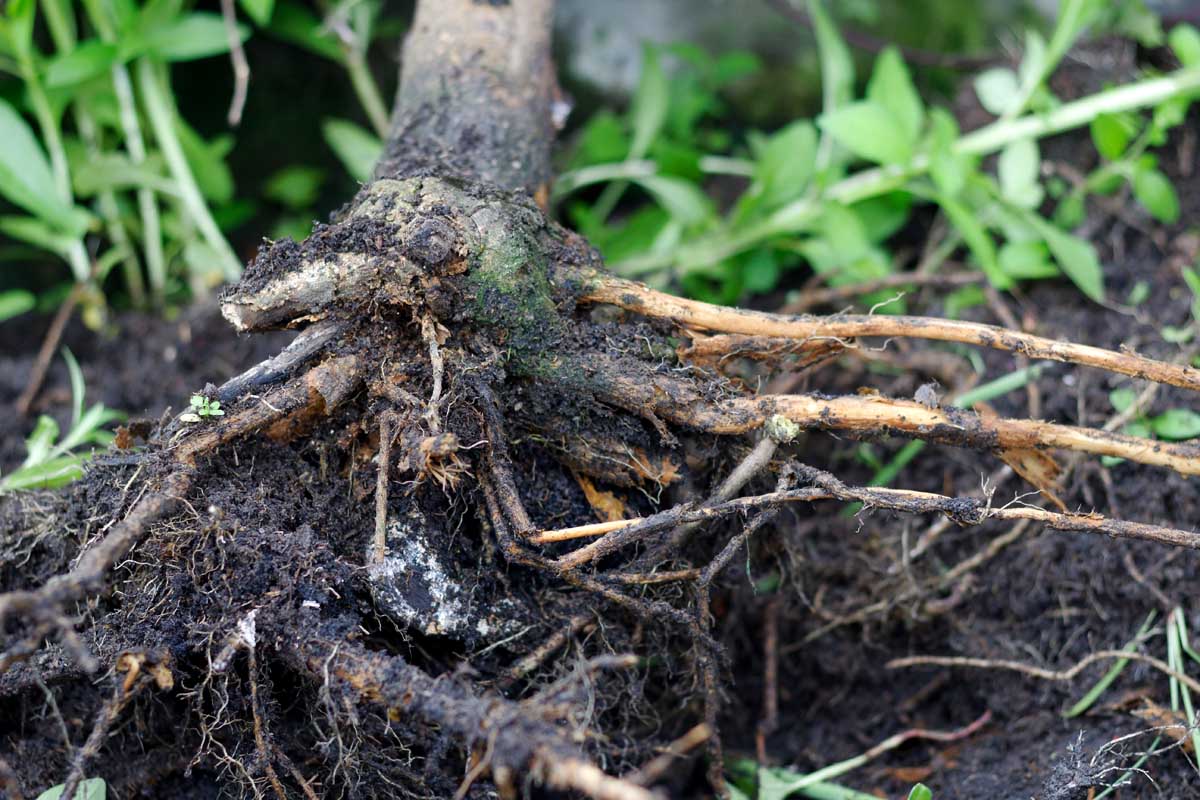
While there are some fungicides that can limit Phytophthora infections, there isn’t much you can do if your tree is showing symptoms of Armillaria, black root rot, or cotton root rot.
Have you waged war against root rot in your fruit, nut, or landscape trees? If so, let us know how It went in the comments below, so that we can learn from your experience.
Looking for more tree disease information? Try some of our other guides:
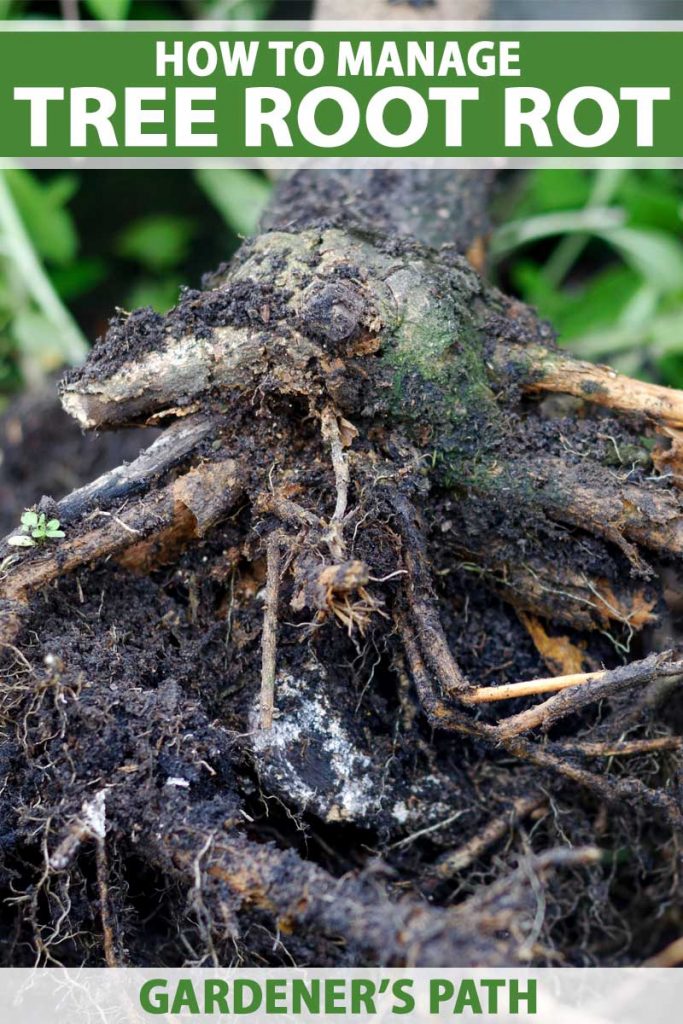
My passion fruit vines died every day. I noticed this type of root rot but I do not know what to do or how to prevent it from ruining other vines.
Hi Visoth, I’m so sorry about your passion fruit vines. Thank you for providing photos! I can only make an educated guess, but the white area in the infected region makes me think that your vines have Armillaria root rot. Unfortunately, there is not much you can do to save your plants if the infection is due to this fungus. However, you might want to have a professional diagnosis done to definitely identify what the problem is. You could hire a landscape company or contact your county extension person. I hope that I am wrong and that it is something… Read more »
I have been battling root rot for 5 years – first off it was very hard to diagnose, my Gardner has no clue, local nursery kept selling me new plants to plant, finally I had a professional Arborist come and he took one look at the hedge – And said Armillaria Root Rot – the hedge was only 5 years old i planted 15 gallons 45 of them it’s 60-70 ft long – 8 ft high, looking great then one by one i started losing one or two each year. Funny thing it would skip one or two and kill… Read more »
Hi Guy, I’m so sorry that you have an Armillaria infection on your property. It’s such a difficult fungus to treat. Removing the soil is a great idea. I would suggest adding some soil amendments when you replant. Fungi like Trichoderma (https://gardenerspath.com/how-to/organic/trichoderma/) can help the plants fight back against fungal infections. And you are right. There is a colony of Armillaria that crosses several states. In fact, it is the largest organism in the world! In total, it weighs more than a whale. In addition, some of the colonies can be thousands of years old – they are that persistent.… Read more »
Great article ! Very hard to find information on how to manage and what plants are resistant…
They also say that there is a fungus that stretches across multiple states!
An arborist and the Agricultural Extension Office have identified a fungus at the base of my very large beech (26″ diameter) as Xylaria polymorpha. I don’t doubt that it’s a saprobic fungus, but the fruiting bodies are no more than 2 or 3 cm tall and only perhaps 4 mm thick. I’m wondering if it’s another Xylaria spp. like X. hypoxylon… but none of the fruiting bodies are clubbed. Whatever it might be, is there any treatment that will slow its growth and prolong the life of my beech, as the beech at this time is showing NO decline?
Hi Bob, Thank you so much for your question! Unfortunately, I am not an expert in Xylaria, so I’ve been trying to find someone who is. There is a gentleman called JD Rogers, who was a plant pathologist at Washington State University in Pullman and has published on Xylaria. He doesn’t appear to currently be a faculty member there. I was able to find a website on the Xylariaceae in Taiwan that has links to email people to ask them questions. I would suggest following up there, and hopefully one of the experts there could guide you to the information… Read more »
Hi Helga, This may be much more simple than your usual questions but saw your post and hoped you could help. My girlfriend recently bought a 6 ft fiddle leaf fig tree and pot from a local nursery here in Santa Barbara, but they didn’t explain the need for drainage. That coupled with the plant roots literally growing up and out of the pot, which I’m assuming is due to the pot being too small, has led to what I can presumably diagnose as a type of root rot. Leaves are developing black spots and falling off. I am going… Read more »
Hi Chanse, I’m sorry to hear about the problems with your fiddle leaf fig. La Sumida Nursery, by chance? Leaf spots are not necessarily due to root rots. They can indicate an infection in the leaves and stem, too. That can be due to a range of pathogens, so I’m not quite sure what advice to give without seeing them. You are welcome to upload a picture, and I could take a look at it. If the roots are growing up and out of the pot, that can mean that the plant isn’t getting enough water. Providing the right amount… Read more »
I have a cherry blossom tree that has grown outside of my house for years, it’s probably about 20 years old. It recently began to have branch dieback on maybe 40 percent of the branches and the leaves look wilted, though they are still mostly green. I started to notice this around the middle of the summer. My dad also began watering it this past spring into the summer, so I fear that the soil could have become waterlogged. I think it may have some type of root rot, though I’m not sure what type. Is there any way I… Read more »
Hi Sophia, I’m so sorry to hear about your cherry tree. It can be difficult to diagnose trees with symptoms like that. You are right that it might well be root rot. However, a closely related disease is crown rot. In crown rot, the infection spreads into the trunk, so it’s more than just an infection of the roots. One thing that might help to diagnose crown rot is to dig slightly beneath the soil line at the trunk and peel back some of the bark. Could you possibly take a picture and post it? I might be able to… Read more »
I have a pepper tree in my front yard that over the last year has lost a ton of its green. It is just not really growing. We’ve cut back on the watering, but I am fearful that it may have root rot. We had an arborist tell us it needed a root drench. What would I use for a root drench?
Hi Brian, I’m sorry to hear that. Root rot in trees is always distressing. That is a surprisingly difficult question to answer, since different types of organisms can cause root rot, and the fungicides that work on fungi will not work on water molds (Phytophthora), and vice versa. I think you need to get a professional diagnosis of what is causing the root rot before you can use a soil drench. A local ag school should be able to do that, or if there isn’t one nearby, you could try your county extension person. They might also be able to… Read more »
I thought I had only one tree with honey fungus but after cleaning my tools and going to the next I realised I was wrong. I am trying to burn the two tree stumps out, will this work?? The next tree has black kind of ring marking on the branches I am cutting – should I be worried about this?? I really would rather not lose the whole of the orchard. The trees have been there for about 30-40 years I think.
Hi Lh, I’m so sorry that you have the honey fungus in your orchard. It can be so devastating. I’m not sure what to make of the black ring markings on your branches. Could you post a picture of them? As for burning the stumps, that is highly diligent of you. You are supposed to remove them, and that seems like a good way to do it. One problem is that the fungi produce those long-lived structures that look like shoestrings called rhizomorphs that spread throughout the soil, and the fungus will colonize any title bits of wood in the… Read more »
I have a Texas Lilac tree/chaste tree about 4 feet tall .. was doing great and growing… new leaves green and blooming … very quickly leaves started turning yellow and I’m not sure what is going on … I live in Austin Texas and it’s in triple digits here… I see them doing well here in many areas… not sure what to do …
Hi Carolyn, it’s hard to say what steps you need to take since yellowing leaves can be caused by so many different things. Since you mention that the yellowing happened rapidly, it’s very possible that it’s a water issue (either too much or too little). While these plants can handle drought conditions, young plants need a bit more water until they’re established. Since it’s hot, you should check the soil and if it isn’t moist a few inches below the surface, add water.
Hello,
I have about 80 Green Giant trees and planted them q3 years ago. Ot seems they have root rot of some sort and we have been losing one a year or so for the past 5 years. I have noticed some way down the healthy hedge now becoming sparse, but not brown yet. What would be the best way to treat them and the area? What would be a good material to drench the soil with to help the remaining trees and I would like to replace the missing end.
Thank you,
Christel
Arborvitae are very sensitive to wet roots and it’s more likely that rot is caused by overwatering or poor drainage than by a disease that you can treat with a soil drench. While there isn’t much you can do about drainage at this point, try reducing the amount of water you’ve been giving the plants. It’s also possible that they’ve been infected by Phytophthora lateralis or Armillaria ostoyae. In that case, you can use a copper soil drench or a product that contains Bacillus subtilis.